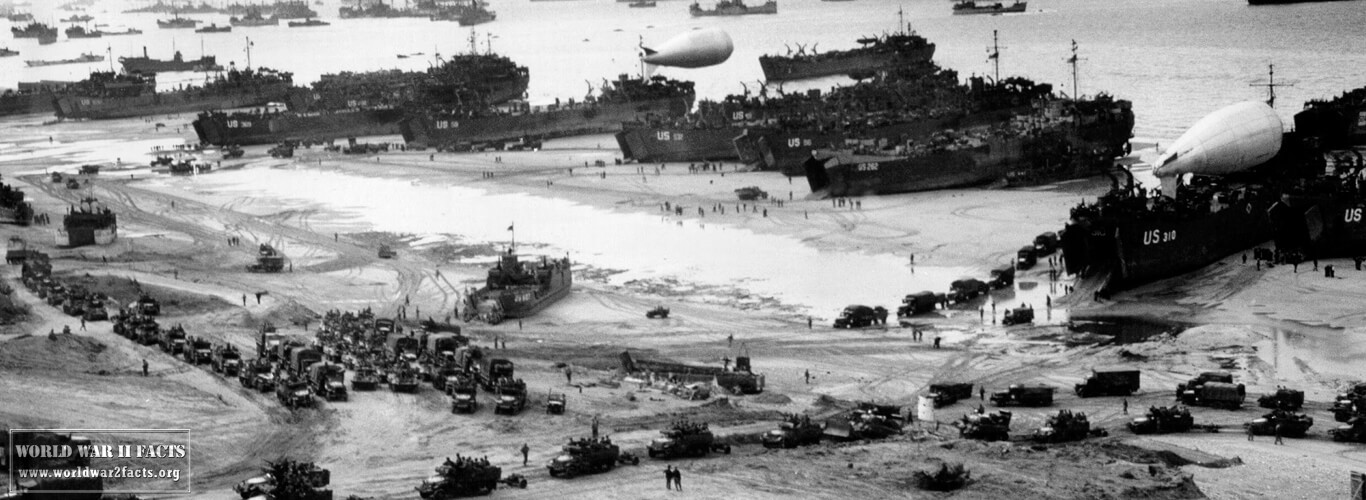USS North Carolina (BB-55) Facts
 North Carolina (BB-55) fast battleship, the most highly decorated American battleship of World War II
North Carolina (BB-55) fast battleship, the most highly decorated American battleship of World War IIThe USS North Carolina (BB-55) was the first North Carolina class of battleships in the United States Navy. The ship was the fourth to be named in honor of the U.S. state of North Carolina and was the first newly constructed battleship to see service during WW 2. North Carolina took part in almost every major U.S. Naval offensive campaign in the Pacific Theater during World War 2 and accumulated 15 battle stars. After decommissioning, the USS North Carolina has served as a memorial and museum ship in Wilmington, North Carolina.
BB-55
Contents
- USS North Carolina Ship Information
- USS North Carolina Ship Characteristics
- USS North Carolina Video
- Building the USS North Carolina
- USS North Carolina’s Service During World War 2
- Pacific Operations During 1944 and 1945
- USS North Carolina Postwar Operations
- Decommissioning and the North Carolina Battleship Memorial
- USS North Carolina References
BB-55 is the designation for the USS North Carolina, a battleship commissioned by the United States Navy in 1941. The USS North Carolina served during World War II. She was involved in several significant naval battles in the Pacific, including the Battle of the Eastern Solomons and the Santa Cruz Islands. The ship was heavily armored and armed with nine 16-inch guns, making it a formidable weapon in naval combat. The USS North Carolina earned 15 battle stars for its service during World War II and is now a museum ship open to the public in Wilmington, North Carolina.
USS North Carolina Ship Information
- Name: North Carolina
- Namesake: North Carolina
- Ordered: 1 August 1937
- Builder: New York Naval Shipyard
- Cost: $76,885,750
- Laid down: 27 October 1937
- Launched: 3 June 1940
- Sponsored by: Isabel Hoey
- Commissioned: 9 April 1941
- Decommissioned: 27 June 1947
- Struck: 1 June 1960
- Nickname: Showboat
- Status: Active Museum ship
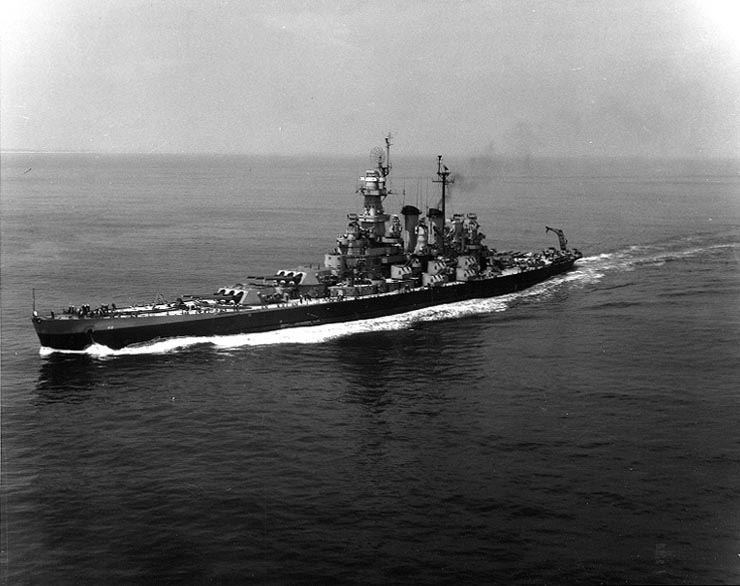
WW 2 Honors and awards:
- 15 Battle Stars
- American Defense Service Medal
- American Campaign Medal
- Asiatic-Pacific Campaign Medal
- Philippine Independence Medal
- Philippine Liberation Medal
- Philippine Presidential Unit Citation
- World War II Victory Medal
- Navy Occupation Medal
USS North Carolina Ship Characteristics
- Class & type: North Carolina-class battleship
- Displacement: 37,484 short tons (34,005 t) (standard)
44,377 short tons (40,258 t) (loaded)
- Length: 728.8 ft
- Beam: 108.3 ft
- Draft: 33.0 ft (10.1 m)
- Installed power: 121,000 hp (90,000 kW)
- Propulsion: Four General Electric steam turbines
eight boilers
four propeller shafts
- Speed: 26 knots
- Range: 17,450 nmi (32,320 km; 20,080 mi) at 15 knots (28 km/h; 17 mph)
- Complement: about 2,339 (144 officers and 2,195 enlisted)
- Sensors and processing systems: CXAM-1 radar beginning in 1940[1]
- Armament: 9 × 16 in (410 mm)/45 calibre Mark 6 guns
20 × 5 in (130 mm)/38 calibre dual-purpose guns
16 × 1.1 in (28 mm) anti-aircraft guns—replaced by 15 quad 40mm antiaircraft guns and 46 single 20mm cannon
- Armor: Maximum: 16 in (410 mm)
- Aircraft carried: 3 × Vought OS2U Kingfisher floatplanes
- Aviation facilities: 2 × trainable catapults on her fantail
USS North Carolina Video
Building the USS North Carolina
The USS North Carolina laid her keel on October 27th, 1937, at the New York Naval Shipyard. The ship was launched on June 13th, 1940, and was sponsored by the North Carolina Governor’s daughter. The ship would be commissioned in New York City on April 9th, 1941, with U.S. Navy Captain Olaf M. Hustvedt in command. The North Carolina was the first of the fast, heavily armored U.S. battleships to be commissioned during WW2, featuring a main battery of nine 16-inch guns!
The North Carolina was the first new battleship to be built by the United States in just over two decades and was limited to a displacement of < 35,000 long tons by the Washington and London Naval Treaties. Her beam was limited to 110 feet due to the width of the Panama Canal at the time, and the draft was limited to no more than 38 feet to ensure that the ship could make use of as many ports and shipyards as possible and proved to be a challenge to naval architects to design. To save weight, the North Carolina used new welding techniques and featured four main spaces containing two boilers and one steam turbine. Each main space was responsible for driving one of the four shafts on the ship, and the arrangement helped reduce the total number of openings in the bulkheads on the boat, saved space, and reduced the overall weight of the ship.
USS North Carolina’s Service During World War 2
USS North Carolina was able to complete her initial shakedown underway in the Caribbean before the Japanese attack on Pearl Harbor. For most of 1942, North Carolina was kept on the eastern coast of the United States for a potential showdown with the German battleship Tirpitz. This battle never occurred, and the North Carolina was ordered to the U.S. Pacific Fleet in the summer of 1942.
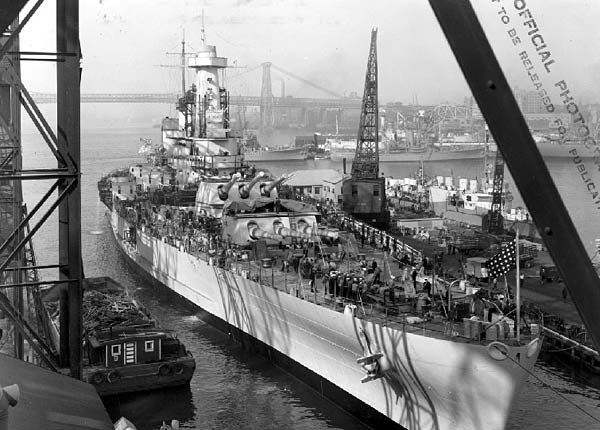
The ship transited the Panama Cana on June 10th, 1942, shortly after the conclusion of the Battle of Midway. North Carolina stopped at San Pedro, California, and San Francisco ports before proceeding to Pearl Harbor, Hawaii. On July 15th, 1942, North Carolina left Hawaii with the Enterprise, heavy cruiser Portland, light cruiser Atlanta, and eight destroyers to seek combat in the South Pacific Ocean.
On August 7th, 1942, the North Carolina assisted in the Battle of Guadalcanal and was the only U.S. battleship active in the South Pacific. She aided in screening the Enterprise who provided air support for the Guadalcanal landings. Later she took part in the Battle of Eastern Solomon’s on August 24th. During the battle, the North Carolina shot down between seven and 14 Japanese aircraft. During the battle, the volume of fire from the North Carolina was so dense, officers of the carrier Enterprise asked, “Are you afire?,” which was not the case. During the engagement, the ship fired more than 840 rounds of 5-inch ammunition, 1,037 rounds of 1.1 inch ammo, 7,425 rounds of 20 mm shells, and 8641 rounds of 50 cal machine guns.
Following the battle, North Carolina shifted to protect the U.S. carrier, Saratoga, during the ongoing engagements on Guadalcanal. On two occasions, North Carolina was attacked by Japanese submarines; once avoiding a torpedo hit through ship maneuvers, and the second time taking a hit on the port side, blowing a 32 ft by 18 ft hole in the side of the ship and killing five men. Torpedoes sank the USS Wasp and O’Brien during this attack. The sailors on the North Carolina could correct a 5.6-degree list and keep the ship in formation and battle ready after the strike. After undergoing repairs in New Caledonia, the ship was dry-docked in Pearl Harbor for hull repairs and to upgrade the anti-aircraft armament. Quickly sent back to sea, the North Carolina took on duties to screen the Saratoga and Enterprise until being taken back to Pearl Harbor in March – April 1943 to obtain advanced radar and fire control upgrades before leaving for the Gilbert Islands in September of 1943.
On November 10th, 1943, the North Carolina sailed from Pearl Harbor as part of the Northern Covering Group with the carrier, Enterprise. The group conducted air strikes on November 19th in support of the assaults on Makin, Tarawa, and Abemama for ten days. The North Carolina provided supporting fire on Nauru on December 8th, 1943 helping destroy beach defense revetments, radio installations, and air facilities. Later in the month, the battleship helped protect Bunker Hill with strikes against airfields and shipping at Kavieng, New Ireland. The ship would then join Task Force 58 under Rear Admiral Mitscher at Funafuti, Ellice Islands.
Pacific Operations During 1944 and 1945
During the Battle of the Marshall Islands, the North Carolina screened the aircraft carriers from air attack during the pre-invasion strikes, provided close air support air shore, and fired on targets in Kwajale, Namur, and Roi, where she was credited with sinking a cargo ship in the lagoon (Roi). Following this action, she was responsible for protecting carriers during the strikes on Truk, and then helped fend off an attack against the Carriers near the Marianas on February 21st before the force conducted strikes on Saipan, Tinian, and Guam. During most of this timeframe, the North Carolina served as the flagship for then Rear Admiral Willis A. Lee, Jr, Commander Battleships Pacific (later promoted to Vice Admiral).
At this point, North Carolina was using Majuro as her base of operations. She helped join in the attacks on Palau and Woleai between March 31st and April 1st and shot down an enemy aircraft during the operation. The force then supported the capture of Jayapura (known as Hollandia at the time) in New Guinea on April 13-24th, followed by a raid on Truk on April 29th-30th, where she dropped another aircraft. After destroying coastal gun emplacements and airfields at Ponape, the North Carolina departed for Pearl Harbor to conduct rudder repairs.
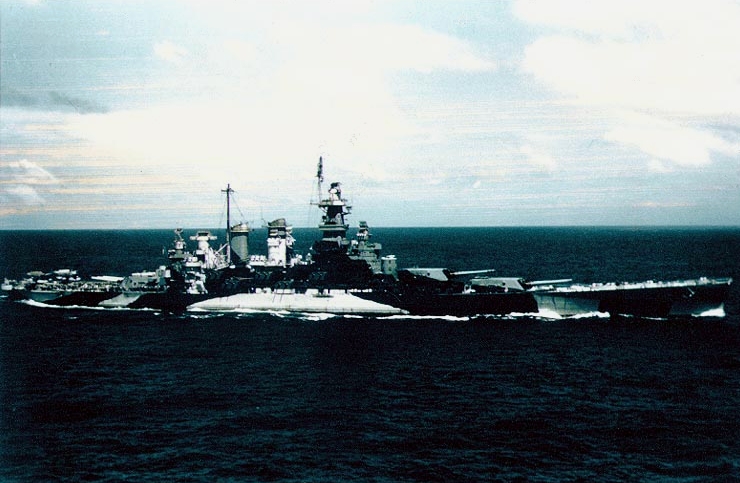
Date November 1943
After completing repairs, the North Carolina sortied from Hawaii with the Enterprise Carrier Group on June 6th, 1944, to proceed to the Marianas. Taking part in the Battle of Saipan, North Carolina protected the carriers and hit the west coast of Saipan, including attacking the harbor at Tanapag. On June 15th, 1944, North Carolina shot down a Japanese aircraft that could pass the American combat air patrol.
On June 18th, the North Carolina proceeded to take part in the Battle of the Philippine Sea and shot down two Japanese aircraft that made it through the American CAP. During the battle, three of the Japanese carriers were sunk, and no American ships were lost. The ship would support air operations in the Marianas for another two weeks before sailing to conduct an overhaul at the Puget Sound Naval Yard. She would ultimately rejoin the U.S. carrier force off Ulithi on November 7th, 1944, when Typhoon Cobra struck the force. As the ships fought through the storm, they carried out attacks against Luzon, Leyte, and the Visayas. Later that month, North Carolina would fight off their first kamikaze attack.
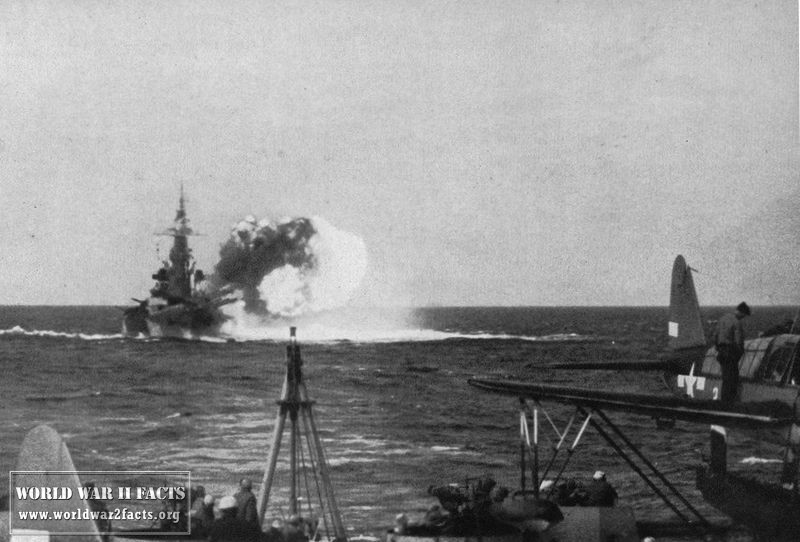
Date 8 November 1943
During this timeframe, North Carolina would continue to screen the U.S. carriers while the Americans would proceed to assault Mindoro on December 15th, 1944. Three days later, the force would sail through another typhoon, losing three American destroyers. The North Carolina would continue to support operations involving strikes on Formosa, the coast of Indo-China and China, and the Ryūkyūs in January of 1945. The strikes conducted on targets in the Japanese home islands helped to support the eventual Battle of Okinawa assault by the Americans, where North Carolina provided both shore bombardment and carrier screening. On April 6th, 1945, she shot down three kamikaze aircraft but took damage from a friendly 5” round resulting in the deaths of three sailors and 44 wounded. After this, the Japanese battleship, Yamato, proceeded south with her escorts but was sunk. The North Carolina would shoot down one Japanese aircraft on this day and two more on April 17th, 1945.
Once the battleship underwent overhaul at Pearl Harbor, she rejoined the carrier force for a month of naval and air strikes against the Japanese home islands. During this time, North Carolina fired on major industrial plants near Tokyo and saved a downed carrier pilot under heavy fire from Tokyo Bay (via her scout seaplane).
USS North Carolina Postwar Operations
As the war closed, North Carolina sent members of her crew and embarked USMC detachment ashore for occupation duty. She would patrol off the coast until anchoring in Tokyo Bay on September 5th to retrieve her men. The ship would embark passengers in Okinawa and depart for the United States. The North Carolina reached the Panama Canal on October 8th and anchored off of Boston on October 17th. Once conducting another overhaul in New York, she would embark U.S. Naval Academy Midshipmen for a summer training cruise in the Caribbean Sea.
Decommissioning and the North Carolina Battleship Memorial
The USS North Carolina was decommissioned in New York, New York, on June 27th, 1947. She would later be stricken from the U.S. Naval Vessel Registry on June 1st, 1960. On September 6th, 1961, the state of North Carolina purchased the ship for $330,000 to be used as a museum. In 1961, the North Carolina was moved via tug boat to her eventual resting place in Wilmington, North Carolina; however, it struck the “Fergus Ark” restaurant near Princess Ann Street and severely damaged the former U.S. Army troopship. On April 29th, 1962, North Carolina was dedicated as a memorial to all North Carolina residents killed during World War 2. In 1986, North Carolina officially declared a National Historic Landmark.
Today, the ship is open to visitors to tour the main deck, some gun turrets, and many interior spaces for a small charge. One of nine surviving OS2U Kingfisher aircraft in the world, which still function, is located on the stern of the ship, and a Roll of Honor in the ship’s wardroom lists all of North Carolinians who died in service of their country during World War 2.
USS North Carolina References
- Naval Historical Society Dictionary of Fighting Ships, USS North Carolina, Last Accessed 24 March 2013
- Historical Naval Ships USS North Carolina Reference Site, Last Accessed 22 November 2013
- USS North Carolina Battleship Museum Website, Last Accessed 19 November 2013
